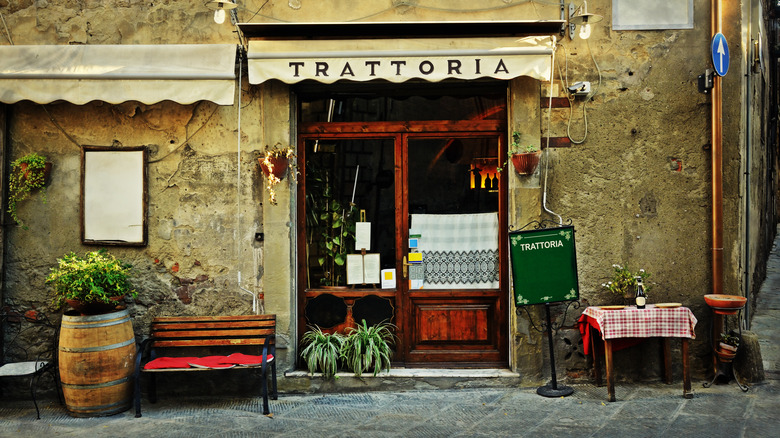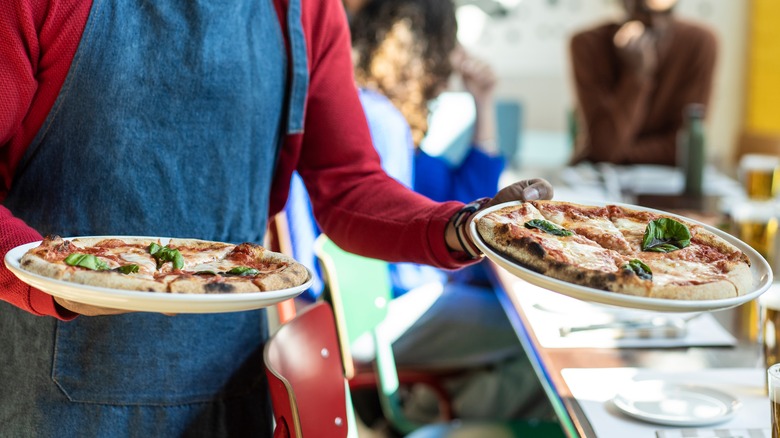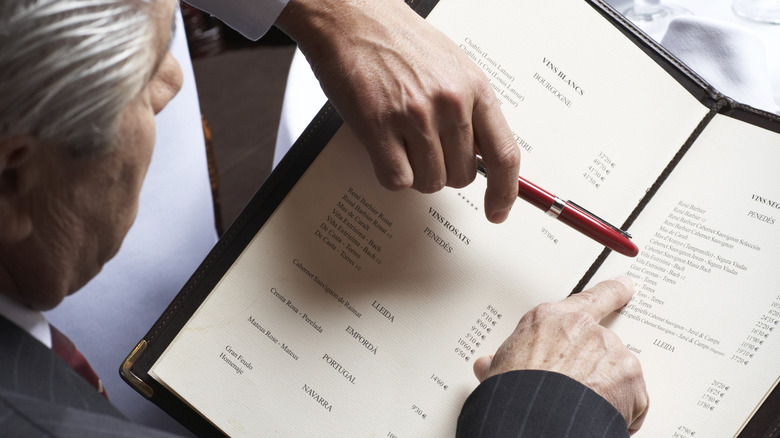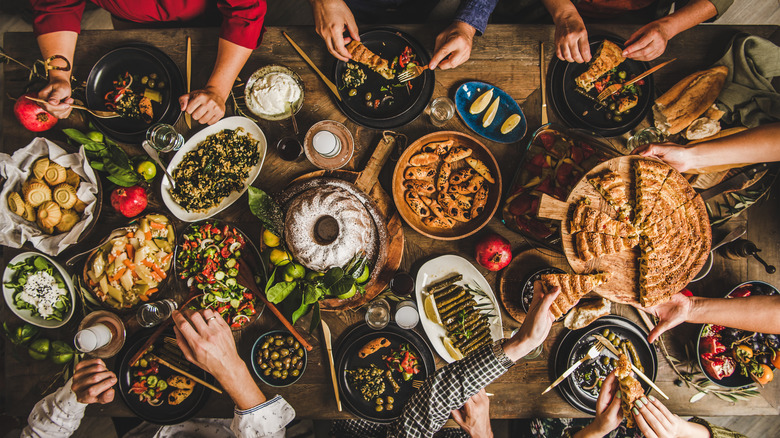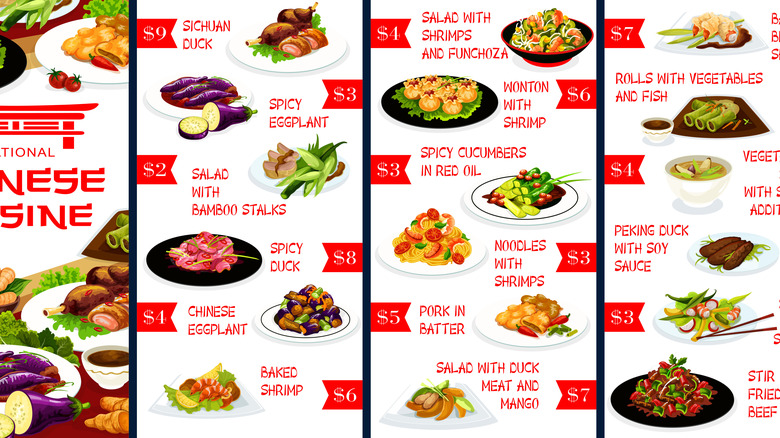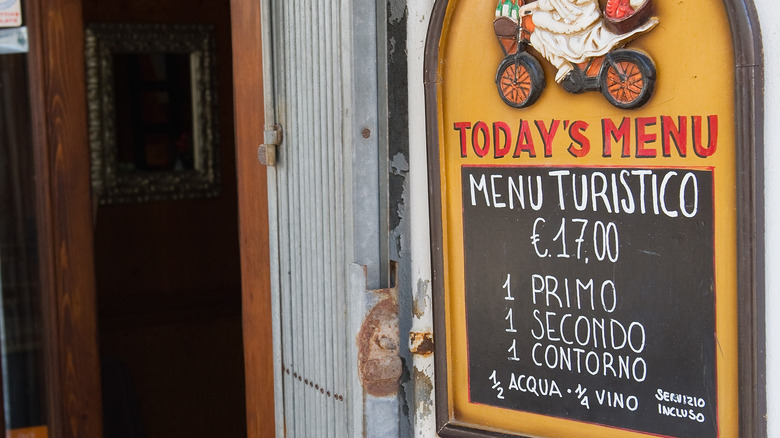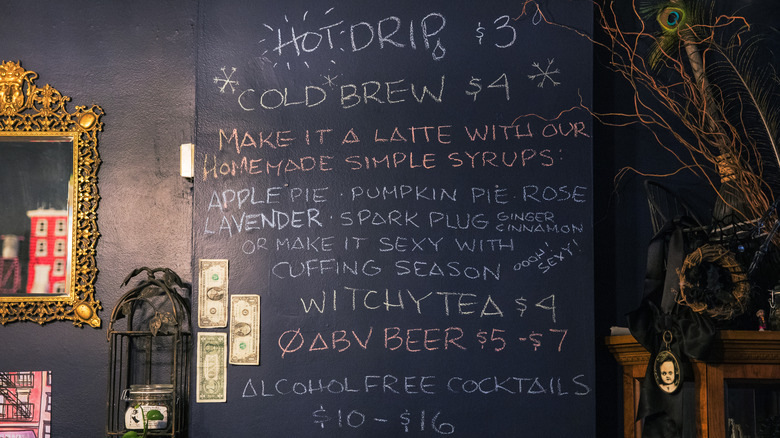Red Flags To Look Out For At Restaurants That Call Themselves 'Authentic'
In the last few decades, the food industry has been flooded with authentic dishes, authentic ingredients, and authentic restaurants. The word is so frivolously used these days that gastronomy got oversaturated with authenticity — and the problem is that it is difficult to explain what the word stands for. When it comes to food and restaurants, it is nearly impossible to pinpoint what makes something real or genuine. Who should be the one to corroborate, confirm, and decide if something is authentic (or at least authentic enough)?
If we try to fit the idea of authenticity in the realm of gastronomy, perhaps it would best describe those restaurants that rely on traditional cooking techniques, familiar ingredients, and time-honored recipes. And though the restaurant business has many fine examples of these places that will directly transport you to the South of Italy or Northern Thailand, many businesses have taken advantage of the authentic trend and tried to brand their restaurant as such without any credibility.
Though it can be tough to recognize these fake authentic spots, we have rounded up a list of some of the easiest ways to identify one. So if you do not want another taste of carbonara with cream or other crimes against authenticity, pay attention to these red flags.
The word authentic is overused
A restaurant that prides itself on traditional dishes and proper use of local ingredients will not feel the need to overemphasize this by constantly pushing the authenticity narrative. Authenticity will be visible in the menu, the choice of ingredients, and how well the ideas translate on the plate. An aggressive campaign to label your restaurant as authentic might even cause a countereffect in which all the effort and energy will be focused on branding instead of letting the cooking take the leading role.
If you come across a restaurant that markets itself with the idea of authenticity, you might end up having the opposite experience. As the word is generally overused these days, many restaurants have tried to blend in with the trend and jump on the authenticity bandwagon. In many cases, authenticity is merely used as a selling point and has no relation to the menu or the quality of the dishes. If you feel that the word is overused on your first glance at the menu, this might be the number one red flag that should deter you from eating at the restaurant (if you can escape after you've seen the menu, anyway). This does not mean that the dishes will necessarily always be poorly executed, but it is a pretty good signal that the place is trying the compensate for some faults or is unable to successfully compete without the overuse of the "authentic" tag.
The menu is too long and inconsistent
The menu always speaks volumes about the restaurant; in some cases, it can be the determining factor that will either direct you inside or swiftly deter you from entering a place. When it comes to restaurants that label themselves authentic, the menu is an excellent tip-off to quickly decide if the label is deserved and if the restaurant is worth visiting.
Generally, long menus are a thing of the past. No one wants to browse through numerous pages filled with dozens of dishes followed by detailed explanations. When you reach the end of these extensive menus, you usually forget where you started. In truly authentic restaurants, you want a concise menu with just a few excellent dishes that will always be perfectly executed. The menu should be short but varied, providing options for everyone.
It should also reflect the philosophy of the place. A menu packed with confusing combinations and dishes that stem from various traditions is a clear signal that authentic labels here are just a cover-up and a way to attract guests. The menus that rely on authenticity will focus on a particular national or regional cuisine. You certainly do not want to see pizzas coming out of old-school BBQ joints or find burgers on menus where the focus is on classic Northern Italian cuisine. This is generally a nice guideline for all restaurants but is particularly important for authentic spots.
The décor is tackily authentic
Sometimes, the décor does not have to be a definite signal of the restaurant's quality, but it will often give you a general idea of what you can expect. Authentic restaurants will always try to implement some decorative elements and furnishings that are supposed to mimic local traditions. However, sometimes you may have a feeling that they went overboard, and this is your signal to think twice about whether you want to go in.
Overly tacky décor is often found in restaurants dislocated from the geographical origins of the food they serve. You can see this in Italian and Chinese restaurants in the U.S. that all resemble each other. Of course, this does not necessarily mean that their food is subpar — you will find some perfectly executed dishes in restaurants that do not pay much attention to aesthetics — but it is always more promising if a location has gone that extra step to find a tasteful way to honor tradition or completely break off from stereotypical practices as the legendary Cecilia Chiang did with her restaurant, The Mandarin.
If you see a plastic string of garlic hanging from the ceiling — which usually comes in a set with kitschy checkered tablecloths at Italian-American trattorias — our suggestion is perhaps to skip the place, but if there is a piece of real prosciutto next to it, by all means, go ahead and see what's on the menu.
There is no regional diversity
If a restaurant is devoted to authentic cooking, it will probably focus on one particular region, especially with nations that thrive on regional specialties, such as Italy, China, India, or Mexico — but any country with a rich culinary heritage will have significant regional differences in its food. The focus on regional dishes will allow much more authenticity and precision, resulting in a menu that will be a genuine representation of traditional cooking without the interference of other regions' specialties, regardless of their popularity.
Though Italian restaurants in the U.S. often like to present themselves as authentic and traditional, in most cases, the menus at American Italian restaurants will include several well-known Italian dishes from around the country — lasagne, carbonara, and tiramisu first come to mind — together with some classics of Italian-American cooking — you are surely familiar with spaghetti and meatballs or mozzarella sticks. Though spaghetti and meatballs can now be considered a classic, the dish has nothing in common with something that you would classify as authentic Italian cuisine.
Some positive changes have been made lately, and you can find a decent number of restaurants in the U.S. that honor genuine regional Italian cooking traditions and could be classified as authentic Italian, but if you see a bizarre fusion restaurant that tries to play the authenticity card, stay away.
Table condiments that are not traditional
Condiments are small but mighty additions that sometimes make or break a dish. At most casual restaurants, a decent selection of condiments will usually wait for you on the table, or you can grab one of those packets on the side if you want extra heat or seasoning on your dish. Unfortunately, we often take condiments for granted, not realizing their enormous potential. These small but potent additions often add that extra touch that will turn your dish from great to spectacular.
We also don't often realize that the proper selection of condiments depends on the type of restaurant, and this is where many restaurants that call themselves authentic go wrong. Like the dishes on the menu, the selection of condiments should also reflect the idea of authenticity that the restaurant tries to convey. Salt and pepper may be standard, but this needs adjusting at certain types of restaurants; for example, at a classic Thai eatery, the dishes crave regional condiments such as fish sauce. If you come across a restaurant that calls itself authentic but doesn't serve typical condiments, it should be a warning signal.
The menu includes stock pictures of the dishes
Having stock pictures on the menu is slightly controversial as it cannot be universally applied to all restaurants. Using kitschy stock photos is generally considered to be a characteristic of tourist trap restaurants where generic images of some classic dishes are placed on the menu so it is easier for tourists to navigate and make an order. However convenient this may sound, it is one of the great sins in the restaurant business and could essentially be classified as false advertising. Menus filled with low-resolution stock images are generally not found in great authentic restaurants — these are the places where you expect the server to explain the dish if it is not familiar to you, and you certainly do not need a generic image depicting a wrongly executed carbonara that will probably not look like the one you ordered.
This is only semi-acceptable at Asian restaurants, as it is more difficult to read the menu if it is written with a different alphabet. Somehow we got accustomed to the idea of seeing these menus at the local Chinese eateries, so it might not be such a big red flag there.
The menu is only available in English
The next thing on the list is an unquestionable red flag for any restaurant that claims to be authentic in a country where English is not the primary language. Adding an English menu should not be frowned upon as it is a great way to make the service faster and more efficient. The problem occurs if this is the only menu available at an "authentic" restaurant. Having only the English-based menu means that you are not expecting to host locals, and this should be the goal as they would be first to approve, praise, and recommend a restaurant if they deem it worthy.
Having only an English menu is a clear sign that a place was designed to cater exclusively to tourists, which strips off any possible trace of authenticity. Also, when abroad, if you ever see a sign for a tourist menu, try to skip the offer as it is usually an over-simplified and overpriced option with no relation to traditional cuisine.
The spelling of the dishes is corrupted
Occasional misspelling is not a crime, and it happens to the best of us, but in particular situations in life, especially in a professional business environment, it can be a deciding factor in whether to pursue or drop a job candidate — or in our case, whether a restaurant lives up to its authentic label. Spelling generally leaves a powerful first impression. It clearly indicates how much care and attention has been invested in a particular task. Therefore, it is a quick and easy way to recognize if a restaurant is devoted to honoring its purported origin, heritage, and tradition.
If you come across a corrupted name of a traditional dish at a restaurant that likes to call itself authentic, it means that the owners do not care enough, and this is a clear red flag you should definitely not ignore. This lack of care could also be reflected in the dishes and the general quality of the restaurant. You want the restaurant to properly use accents and write the correct names of the dishes in their original form. It takes mere seconds to check how the dish is spelled in its original language, so any spelling flaws should be a cue that the restaurant is not truly devoted to preserving and promoting authenticity.
Staple menu items are not made in house
Every traditional restaurant has its forte — the star ingredient or dish whose quality is outstanding and is the main reason for visiting. In Italian trattorias, pasta takes center stage, and any Mexican place worth visiting probably has excellent tortillas or freshly made salsas. The success of these types of restaurants depends on whether these staple items are made in-house. Freshly wrapped sushi always beats the prepacked stuff and the tenderness of fresh dumplings cannot be compared to anything that has spent too much time in refrigeration.
House-made items are a general sign of good quality, but in restaurants that like to call themselves authentic, it is paramount that these classic staples are made at the location. This says a lot about the commitment to making things as genuine as possible. It does not have to be a cheerful Italian nonna rolling all that stiff pasta dough, but seeing a chef in the back pushing thin ribbons of tagliatelle out of a pasta machine would definitely signal that the place is devoted to delivering an authentic culinary experience. If you don't notice the aroma of freshly baked bread at a French restaurant or the whiff of smoke coming out of the back of a Southern BBQ joint, these are not the places you should be spending your money if you're looking for authenticity.
The staff is not knowledgeable about traditional dishes served at the restaurant
Front-of-house staff are the face of every restaurant and the first people the guests encounter. Though food is always central in gastronomy, the FOH staff is vital in maintaining the desired image for your business. Polished, polite, professional, and assertive would be some general qualities of well-trained hosts and servers.
Moreover, you want the staff to be able to present the dishes properly. Though this is a general principle for any restaurant and most hospitality businesses, it is even more significant in authentic restaurants as the menus are often filled with unfamiliar items or words that need further explanation. This is most common at places serving food from other countries where the customers are often not familiar with the ingredients in a particular dish, cooking techniques, or dining etiquette. You want to have a well-trained staff who will present the dishes with confidence and persuade the customers to try various options. If the servers have no idea what is inside a particular dish, this will probably be a reason to doubt the whole authenticity narrative.
If the menu features plenty of unfamiliar names, the staff should also be trained and able to pronounce them correctly. This would be firm evidence that tradition is important and honored.
There are no traditional drinks on the menu
Whether alcoholic or non-alcoholic, beverages make a natural accompaniment to food, and when creating a menu, these things cannot be looked at separately. Though they are usually paired naturally, some thought has to be put into the process if you do not want your menu to be a complete mess. If it is a burger joint, you would expect to find at least a nice selection of brews, and you would rarely pair a classic cheeseburger with some expensive Burgundy red — though we have nothing against it if that is your thing.
At restaurants that are branded as authentic, it is the drink menu that can tell you how much effort has been put into respecting traditional culinary practices. At the best traditional restaurants, the drink menu will reflect the same idea of authenticity as the food. Local drinks will be represented. Just like food, or sometimes even more so, drinks reflect terroir, especially if we are talking about wines. Sometimes the two work in such perfect harmony that separating them would be a sin. If there is no sake at the sushi bar or lassi at the new Indian spot, this should be a hint for you to skip your planned visit.
The menu is packed with grossly misinterpreted traditional dishes
The biggest red flag comes last on the list. Grossly misinterpreted dishes that are incorrectly executed have long been associated with restaurants that like to falsely call themselves authentic. Taking a traditional dish, sometimes with a centuries-long history, and adapting it by adding completely unnecessary ingredients or removing some of its essential components so that it would appeal to the broader population is a bad move. This is especially true if the restaurant owner did not grow up in the cultural tradition they are butchering. It shows disrespect toward culinary heritage and can easily be classified as an example of cultural appropriation. Of course, if you are going for the fusion concept, there is absolutely nothing wrong in blending and creating something new, but make sure it is branded as such and do not try to shove it into the authentic box.
Authenticity is not seen in checkered tablecloths or black-and-white images of rustic landscapes. It is not packed in lanterns or sombreros. Authenticity is in the dishes that come out of the kitchen, and any faults in the food department should be the most significant red flag at any supposedly authentic restaurant.
